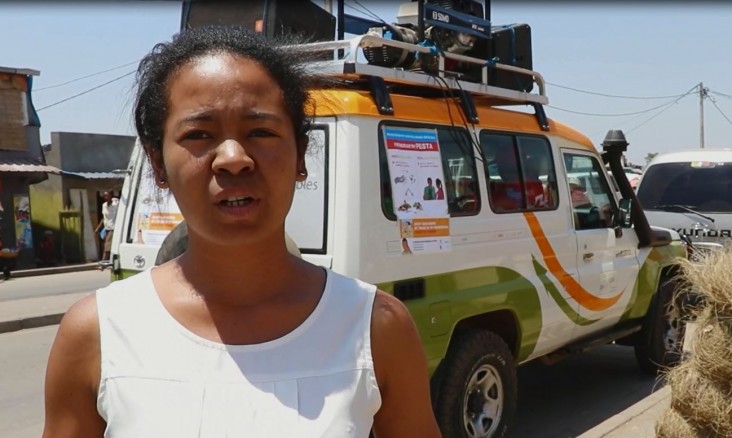Speeches Shim

People turn to stare as the truck rumbles through the narrow, pedestrian packed street.
From the loudspeakers mounted on the roof pours a steady stream of commentary, urging the Malagasy people to take action.
People in Antananarivo, Madagascar are used to the sight of trucks like these. They are common fixtures on the streets during election periods, when candidates solicit votes. But this isn’t an election period and these messages are even more serious than politics.
Na aiza ianao na aiza, na any ambanivohitra na aty an-drenivohitra, dia mety ho voan'ny pesta– Wherever you are, in rural or urban areas, you may be affected by plague.
Azo tsaboina tsara ny pesta, ary tsy andoavam-bola – Plague is treatable and treatment is free.
Raha misy soritr'aretin'ny pesta ianao na olona fantatrao, mandehana haingana any amin'ny tobim-pahasalamana atao fitiliana. Antsoy ny laharana maitso 910 raha mila fanampim-panazavana mikasika ny pesta – If you or someone you know has plague symptoms, go immediately to a health center for screening. Call the emergency umber – 910 – for more information about plague.
These mobile audio units are just one part of USAID’s response to a plague outbreak in Madagascar that has already claimed over 125 victims.
One of the voices over the loudspeakers belongs to Julie Ramiharisoa, from Madagascar’s Ministry of Public Health, who explains that a key part of the plague response is ensuring people understand the disease and how to react.
“The goal of this mobile awareness raising campaign is to inform the people, wherever they are, about what plague is, how it is transmitted, what the symptoms and other preventive measures are, and where to go if you suspect there is plague at home, because plague affects the individual indiscriminately and everyone may get it.”
Plague occurs every year in Madagascar, with cases emerging between October and April, usually in remote, rural locations. However this year there were two major differences. Plague emerged in two of Madagascar’s major urban centers – the capital of Antananarivo and the eastern port city of Toamasina. The dominant form of plague was pneumonic, which is spread human-to-human through close contact, while the more common but less easily transmissible bubonic plague is mainly spread through the bite of infected fleas.
Within a matter of weeks the number of plague cases rose dramatically higher than a normal year and health officials scrambled to respond. Members of the international donor community, including USAID, were there to support the Malagasy government’s response efforts.
The mobile audio units are operated by the USAID-funded Integrated Social Marketing activity implemented by Population Services International (PSI). The activity is also coordinating the national plague hotline that people can call to get information and resources on plague symptoms, where to go for treatment, and available support services.
In addition to these public communication activities, USAID has provided the Ministry of Public Health with mobile clinics to transport patients and vehicles to support contact tracing and surveillance. USAID has also provided Madagascar with personal protective equipment including 200,000+ gloves, 45,000 respirators, 4,000 goggles and 2,000 alcohol hand rubs. Over 15,000 USAID-supported community health volunteers are now trained to respond to plague in their own communities across Madagascar. Other USAID partners, along with the Centers for Disease Control and Prevention (CDC), are providing infection prevention control training, funding for hygienist staff, and technical assistance to the Ministry of Public Health. Finally, USAID has provided additional funding to Institut Pasteur Madagascar to boost their laboratory capacity.
Along with other development agencies, including the World Health Organization and UNICEF, USAID is playing a key role in plague response efforts and strategic planning, working closely with the Government of Madagascar.
As he watched and listened to the mobile audio unit moving through his neighborhood, a middle-aged man named Bera was appreciative of the efforts that were being done to protect the Malagasy people.
“As everybody knows, plague is spreading in the country. Your awareness raising effort is good, very good. Some people have a vague knowledge of plague, and there’s a need to explain to them. I think this outbreak is due to many things that were not observed; we need to raise the people’s awareness of hygiene.”
For more information about USAID efforts to respond to Madagascar’s plague outbreak, visit www.facebook.com/usaidmadagascar.

Comment
Make a general inquiry or suggest an improvement.